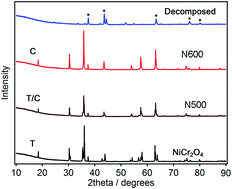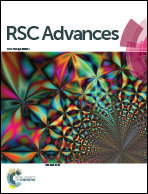Effect of nitrogen substitution on the structural and magnetic ordering transitions of NiCr2O4†
Abstract
The nitrogen (N) doped spinel NiCr2O4 has been synthesized at 773 K (N500) and 873 K (N600) by ammonolysis of NiCr2O4 powders to study the effect of anion doping on its structural and magnetic properties. The N contents are determined by thermogravimetric oxidation, yielding a composition that can be described as NiCr2O3.68N0.21 (N500) and NiCr2O3.55N0.30 (N600). X-ray photoelectron spectroscopic studies suggest that N3− species partly substitute the oxygen in the lattice and oxygen vacancies exist in the N doped samples. There is evidence that in the nitrided sample, the Cr ion is most likely in a mixed oxidation state. As the N content increases, the structure at room temperature changes from tetragonal to the cubic phase; N500 is only partially tetragonal; N600 is completely cubic. Such structural change is the consequence of the depression of the cooperative Jahn–Teller effect of Ni2+ in the tetrahedral A site caused by the presence of N3−. Combined heat capacity and temperature dependent magnetic susceptibility measurements give clear evidence of the magnetic and structural transitions in the N doped NiCr2O4. The Jahn–Teller transition temperatures decrease with increasing N content; this is likely due to increased covalency and hence enhanced contribution of the angular momentum and the spin–orbit coupling to local chemical bonding around Ni2+. Antiferromagnetic transitions are observed at TS = 23 K and 22 K for N500 and N600, respectively. Hence there is indeed a lowering of transition when compared to pure NiCr2O4 (28 K). The magnetic loops at different temperatures confirm that the material behaves as a paramagnet over a wide range of temperatures T ∼ 80–350 K. The material also exhibits a canted ferrimagnetic structural transition between 30 and 70 K. We also report evidence for increased frustration and lowered correlation length in N doped compounds compared to the parent NiCr2O4. The present study on N− doping effects on the structure and magnetic properties of this NiCr2O4 is expected to be useful for tailoring the ferric phase transitions through anion substitutions.


 Please wait while we load your content...
Please wait while we load your content...